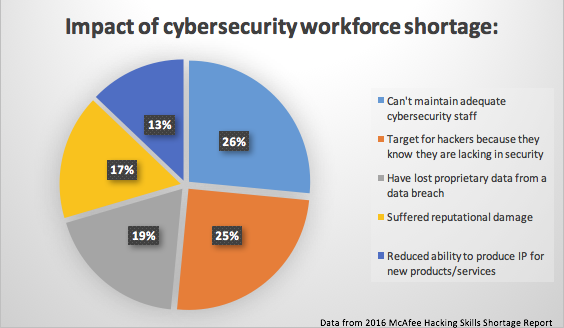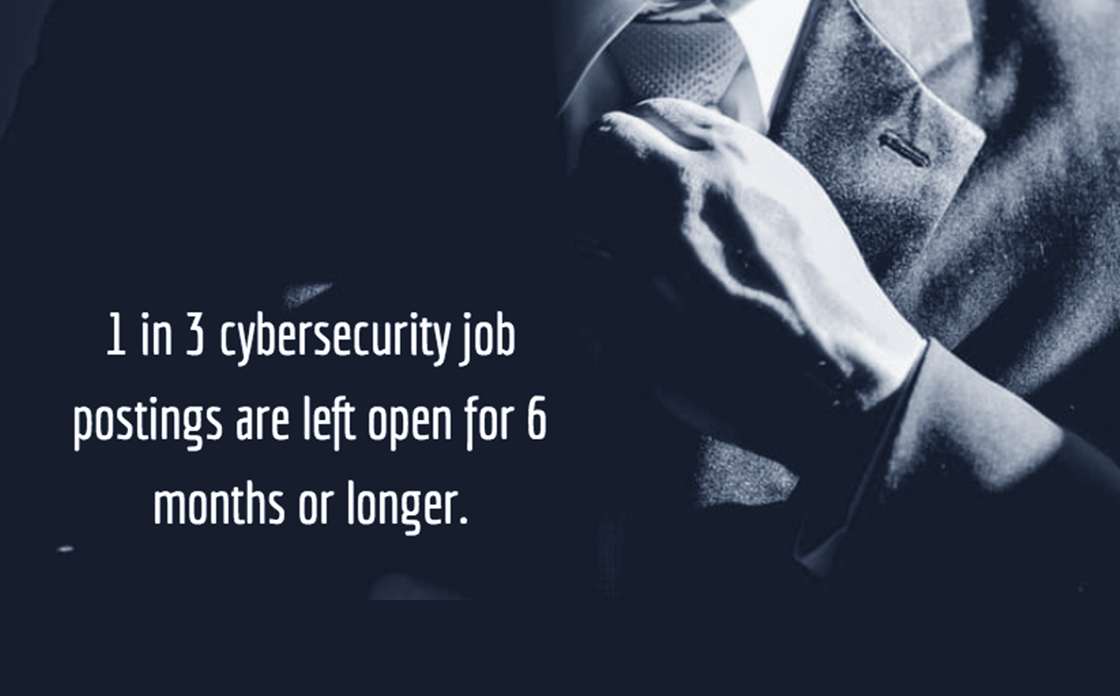According to the Identity Theft Center, data breaches increased 40 percent in 2016 over 2015. So far, it looks like 2017 is going to be even worse.
The best way to combat these threats is to invest in strong cybersecurity technology and experienced staff. And, in fact, companies are predicted to spend over $100 billion annually on cybersecurity by 2020.
By all means invest in the latest tools and infrastructure, but your security operations center (SOC) will still need a strong team to maintain that infrastructure, investigate alerts and rectify problems. Unfortunately, while there are loads of cutting edge tools available – there is a serious cybersecurity staffing shortage that is leaving many organizations vulnerable.
 An estimated 1 in 3 cybersecurity job postings are left open for 6 months or longer.
An estimated 1 in 3 cybersecurity job postings are left open for 6 months or longer.
By 2019 1 to 2 million cybersecurity jobs will remain unfilled around the world.
This demanding environment creates a problem that is three-fold:
- It’s hard to hire people.
- It’s hard to train people.
- It’s hard to retain people.
The good news?
Security automation and orchestration (SAO) can help you solve all three of these issues.
It’s hard to hire people.
Security orchestration makes your team more efficient so you don’t need to hire as many people.
Manage your security infrastructure with the staff you already have.
- SAO automates many time-consuming tasks so your employees can answer more alerts in the same amount of time.
- SAO consolidates disparate sources of information and provides context for each alert so that employees can quickly evaluate the seriousness of any given alert.
- SAO automates up to 80 to 90 percent of the security tasks your team now performs manually.
It’s hard to train people.
SAO documents tribal knowledge so it is easier to train people.
Security automation solutions mimic the procedures and practices of the best members of the SOC team.
When adopting an SAO, incident response processes get explicitly defined by human users in great detail so that the SOC can then model and automate those processes with the SAO. What’s more, the solution can show how any given situation has been handled previously (as well as the results of that process). As a result, the processes for every situation are embedded (but still able to be modified) in the solution itself.
By “remembering” how things get done, SAO makes new and junior personnel much more productive. Just as importantly, this documentation can mitigate the knowledge loss when people inevitably leave.
It’s hard to retain people.
SAO makes people’s jobs more fulfilling and less stressful so it’s easier to retain people.
Turnover is a huge problem for security operations teams. Turnover increases costs and reduces security team effectiveness. And let’s face it, high industry turnover isn’t surprising when you look at the extremely tight overall IT security job market combined with the daily grind faced by many SOC staff dealing with a never-ending series of security alerts.
Repetitive, manual security administrative tasks can lead to burnout, especially among highly skilled staffers. With SAO, team members are able to focus on what matters and get less distracted (and bored/burned out) by routine, repetitive work like cutting and pasting information from one tool into another for analysis, sending email updates, and changing alert priorities.
By automating many of the time-consuming investigatory steps necessary for researching an alert, your cybersecurity employees can focus on actual threats. Instead of performing rote procedures, your employees can stretch their minds and focus on doing the real investigative and correlation work they enjoy. And when your cybersecurity employees get to use their skills and training to investigate significant threats, they feel valued and engaged – boosting productivity and overall security.
According to a recent Gallup survey, two-thirds of employees in America feel unengaged at work. Some of them could be working in your SOC.
The Swimlane solution
Swimlane provides a security automation and orchestration solution that works in conjunction with your existing security systems, without the need for connectors or other customized software development. Centralized dashboards make it easy for your cybersecurity employees to have a clear understanding of security within your organization. Instead of being overwhelmed and bored by alerts, they can focus on legitimate threats.
Swimlane enables:
- Real-time visibility and oversight of security operations within your organization
- Optimization of staffing levels/costs
- Earlier attack chain response
- Increased situational awareness
- The automation of many time-consuming incident response processes
Reduce staff turnover, engage your employees, and protect your organization with Swimlane. Do you want more detailed information on the benefits of SAO? Download our eBook.


